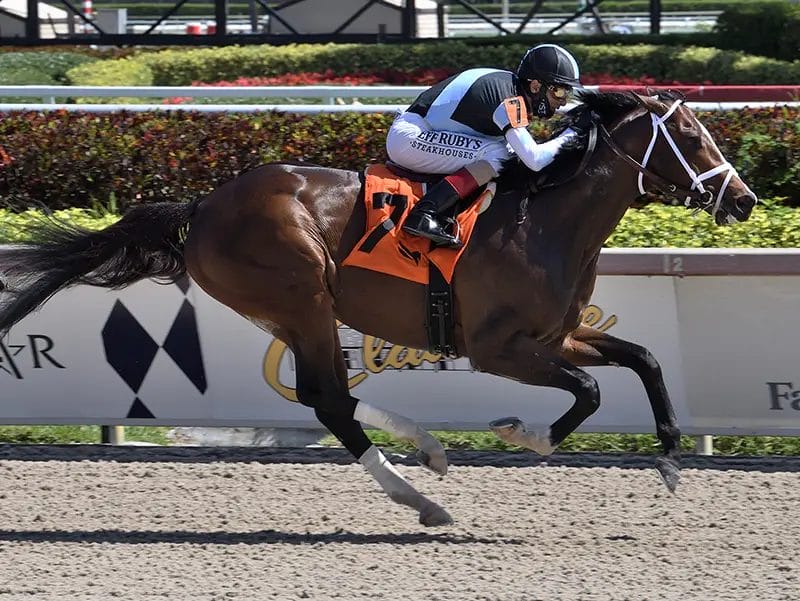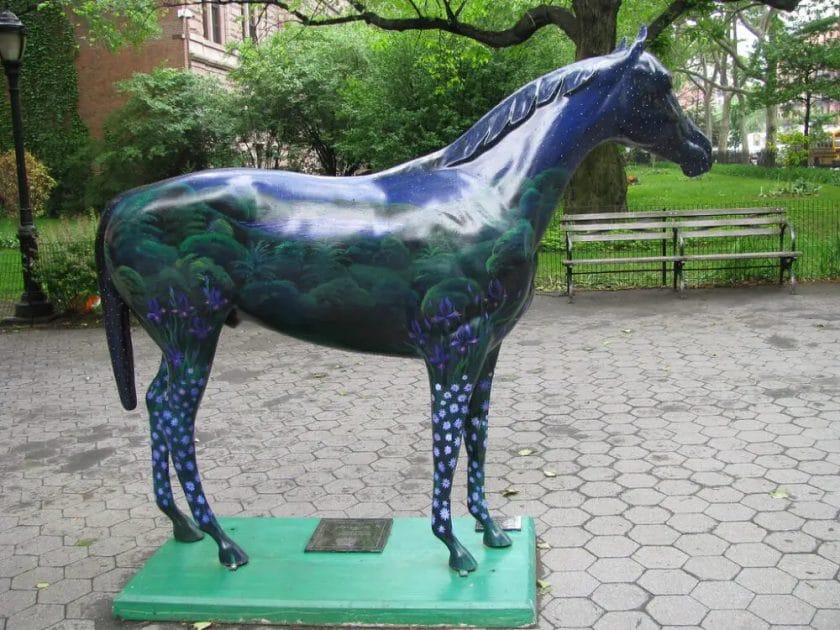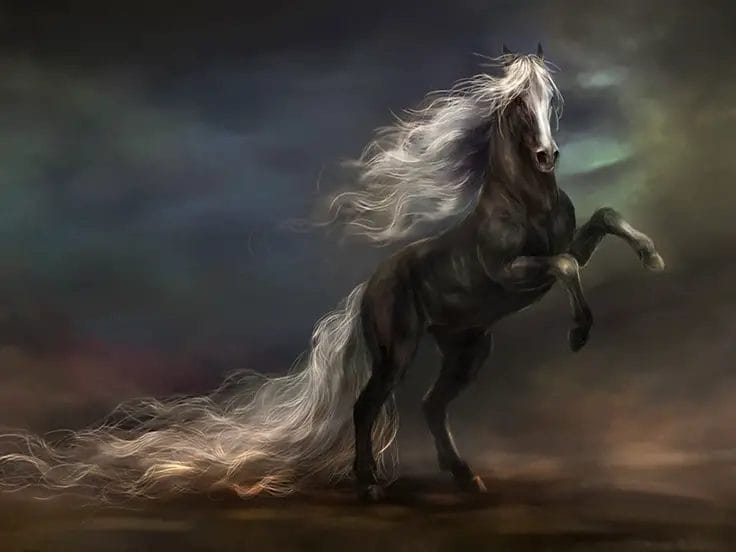Horses are not nocturnal animals. They are diurnal creatures, meaning they are most active during daylight hours. Horses have evolved to have excellent vision, which allows them to see well in the day and detect potential threats. They have a natural sleep pattern that consists of intermittent periods of rest and short bouts of sleep. While horses are generally more active during the day, their sleep cycles can be flexible and may vary depending on their environment and individual preferences.

The Myth of Nocturnal Horses: Debunking Common Misconceptions
There is a prevailing myth that horses are nocturnal creatures, actively engaging in activities during the night while resting during the day. However, this notion is far from the truth. In this section, we will debunk this common misconception and shed light on the actual behavior of horses.
Contrary to popular belief, horses are diurnal animals, which means they are primarily active during the day and sleep during the night. Their natural instincts and physiology are aligned with the cycle of the sun, making them highly productive during daylight hours.
Horses have a remarkable ability to adapt their behavior to different environmental factors, including the amount of daylight. This is known as the photoperiodic response. Horses possess a specialized structure called the pineal gland, which interprets light signals and regulates their internal clock.
During the day, horses engage in a variety of activities such as grazing, socializing with their herd, and engaging in light exercise. Their keen senses, particularly their vision, are well-suited for daylight conditions, enabling them to efficiently navigate their surroundings and detect potential threats.
As the sun sets and darkness descends, horses enter a period of rest and sleep. They typically find a comfortable spot in their pasture, lie down, and relax. Horses are not completely still during their resting period; they may shift positions, twitch their muscles, and occasionally get up to stretch or reposition themselves.
It is important to note that horses have a unique sleep pattern known as polyphasic sleep. Unlike humans who have consolidated sleep patterns, horses alternate between periods of deep sleep and shorter periods of lighter sleep throughout the night. This adaptation allows them to quickly respond to predators or other potential dangers.
Another reason why the myth of nocturnal horses persists is the occasional nighttime activity exhibited by some horses. This can be attributed to various factors, such as changes in routine, discomfort, or environmental stimuli. However, these instances are exceptions rather than the norm for equine behavior.
Understanding the true nature of horses as diurnal animals is essential for their overall well-being. Providing them with a consistent routine that aligns with their natural instincts promotes a healthy lifestyle. Access to ample daylight, regular exercise, and a suitable sleep environment are key factors in ensuring their physical and mental well-being.
In summary, horses are not nocturnal creatures as commonly believed. They are diurnal animals that thrive during the day and rest during the night. Their behavior is regulated by the photoperiodic response and their unique sleep patterns. By debunking the myth of nocturnal horses, we can better understand and appreciate these magnificent animals.

The Natural Sleeping Patterns of Horses: Insights into Their Nocturnal Behavior
Horses are fascinating creatures that have captivated humans for centuries. Yet, despite our close relationship with these majestic animals, there are still many aspects of their behavior that remain mysterious. One such aspect is their sleeping patterns, particularly their nocturnal behavior. In this section, we will delve into the natural sleeping patterns of horses and gain insights into how they sleep at night.
Contrary to popular belief, horses do not sleep like humans do. They do not have the luxury of lying down for several hours at a time. Instead, horses have ingenious ways of getting the rest they need while remaining on their feet.
One of the most interesting aspects of horse sleep is their ability to enter a state of sleep known as “REM sleep” or Rapid Eye Movement sleep, which is typically associated with dreaming. During REM sleep, horses exhibit various behaviors that indicate they are in a deep sleep. These include twitching of the muscles, flicking of the ears, and occasionally even snoring!
Despite their ability to enter REM sleep, horses spend only a fraction of their sleep time in this state. In fact, research suggests that horses spend approximately 2-3 hours out of every 24-hour period in REM sleep. The majority of their sleep time is spent in a lighter state of sleep known as “quiet sleep” or non-REM sleep.
During quiet sleep, horses are still able to rest and relax, but they are more alert to their surroundings. Their muscles remain tense, allowing them to quickly respond to any potential threats. This is an essential survival mechanism for horses, as they are prey animals and need to be ready to flee from predators at a moment’s notice.
In addition to their unique sleep patterns, horses also have the ability to take short naps throughout the day and night. These naps, known as “microsleeps,” can last anywhere from a few minutes to an hour, and horses can take them either standing up or lying down. Microsleeps allow horses to quickly recharge and catch up on much-needed rest.
It is important to note that the natural sleep patterns of horses can be influenced by their environment and social dynamics. Horses that are kept in domesticated settings may have disrupted sleep patterns due to factors such as confinement, noise, and social interactions. In contrast, wild horses have the freedom to choose when and where they sleep, which may result in more natural sleep patterns.
In summary, the natural sleeping patterns of horses are unique and adapted to their survival in the wild. While they do experience REM sleep, the majority of their sleep time is spent in a lighter state known as quiet sleep. Horses also have the ability to take short naps throughout the day and night, allowing them to recharge and stay alert. Understanding these sleeping patterns can help horse owners and caretakers provide the best environment for their equine companions and ensure they get the rest they need.

Understanding Horses’ Adaptation to Low-Light Conditions: The Nocturnal Advantage
Horses are magnificent creatures known for their strength, grace, and beauty. One of their most fascinating characteristics is their ability to adapt to low-light conditions, allowing them to navigate and thrive in the darkness. In this section, we will explore the intriguing phenomenon of horses’ nocturnal advantage and delve into the various adaptations that enable them to excel in low-light environments.
1. Evolutionary Background:
Horses have a long evolutionary history of living in open grasslands and plains, where they have evolved to encounter a wide range of lighting conditions. This includes both broad daylight and dimly lit environments such as dusk and dawn. Over time, horses have developed specialized adaptations to help them navigate effectively in low-light conditions.
2. Enhanced Night Vision:
One of the key adaptations that allows horses to excel in low-light conditions is their exceptional night vision. Their eyes are designed to gather as much light as possible, thanks to several factors:
- Large Pupils: Horses have large, dilated pupils that can open wider than those of humans or many other animals. This allows more light to enter the eye, maximizing their ability to see in the dark.
- Tapetum Lucidum: The tapetum lucidum is a specialized layer of tissue located behind the retina. It reflects light back through the retina, enhancing the horse’s sensitivity to dim light.
- Rods and Cones: Horses have a higher concentration of rod cells in their retinas, which are more sensitive to light and specialized for low-light vision. Cones, responsible for color vision, are less prominent in comparison.
3. Superior Depth Perception:
Another remarkable adaptation that aids horses in low-light conditions is their superior depth perception. Their eyes are positioned on the sides of their heads, providing them with a wider field of view. This panoramic vision enables horses to detect subtle movements and judge distances accurately, even in dim lighting.
4. Enhanced Hearing:
While vision is crucial, horses also rely on their acute sense of hearing to navigate effectively in low-light environments. Their large, mobile ears can rotate and swivel, allowing them to pinpoint the direction of sounds. This heightened auditory perception helps them detect potential threats or prey, enhancing their overall survival in the darkness.
5. Other Adaptations:
In addition to their exceptional vision and hearing, horses possess other adaptations that contribute to their nocturnal advantage:
- Sensitive Whiskers: Horses have long and highly sensitive whiskers around their muzzles. These whiskers act as tactile sensors, helping them navigate and detect obstacles even in darkness.
- Keen Sense of Smell: Horses also possess a keen sense of smell, which aids in detecting food sources and potential dangers in low-light conditions.
- Natural Camouflage: Horses have evolved to blend in with their surroundings, especially during twilight hours. Their coat colors and patterns help them remain inconspicuous, providing an added advantage when moving under the cover of darkness.
Summary:
Horses possess a remarkable ability to adapt to low-light conditions, granting them a nocturnal advantage. Their large pupils, tapetum lucidum, and specialized retinas enable them to see in the dark with enhanced night vision. Furthermore, their panoramic vision, acute hearing, and other adaptations allow them to navigate and thrive in low-light environments. Understanding these unique adaptations provides us with a deeper appreciation for the incredible abilities of these majestic creatures.
Exploring the Sleep-Wake Cycle of Horses: Unveiling their Nighttime Activities
Horses, majestic creatures known for their grace and power, have long fascinated humans. One aspect of their life that has intrigued researchers is their sleep-wake cycle. While it is well-known that horses require sleep, the specifics of their nocturnal activities have remained a mystery. In this section, we will delve into the sleep patterns of horses and explore the intriguing behaviors they exhibit during the night.
The Sleep-Wake Cycle of Horses
Like humans, horses have a circadian rhythm that regulates their sleep-wake cycle. However, their sleep patterns differ significantly from ours. While humans typically have consolidated periods of sleep during the night, horses have a polyphasic sleep pattern, meaning they sleep in multiple short episodes throughout the day and night.
Horses are classified as “obligate sleepers,” which means they must lie down to enter rapid eye movement (REM) sleep, also known as dreaming sleep. Unlike humans, horses cannot achieve REM sleep while standing. Therefore, they require specific conditions to engage in this vital sleep stage.
Unveiling Nighttime Activities
Contrary to popular belief, horses are not completely inactive during the night. While they do need rest and sleep, they also engage in various activities under the cover of darkness. Let’s take a closer look at some of the nighttime behaviors exhibited by horses.
Resting and Dozing
During the night, horses spend a significant amount of time resting and dozing. They may find a comfortable spot in their pasture or stable to lie down and relax. This resting period allows them to conserve energy and rejuvenate their bodies.
Grazing and Foraging
Horses are natural grazers, and their nighttime activities reflect this instinct. Even in the darkness, horses can be seen quietly grazing on grass or foraging for food. They have excellent night vision, allowing them to navigate their surroundings and find suitable sources of nourishment.
Social Interactions
Horses are highly social animals, and their interactions with herd members continue during the night. They may engage in mutual grooming, playfulness, or simply stand together for companionship. These social interactions help to maintain the cohesion and hierarchy within the herd.
Moving and Exploring
Horses are naturally curious creatures, and the cover of darkness provides them with the opportunity to explore their environment without distraction. They may wander around their pasture, investigate new scents, or investigate unfamiliar objects. This exploration helps to satisfy their innate curiosity and provides mental stimulation.
Safety and Vigilance
Despite being prey animals, horses possess a remarkable sense of vigilance. They remain alert even during sleep and are attuned to their surroundings, constantly on the lookout for potential threats. Horses may take turns keeping watch while others sleep, ensuring the safety of the herd.
Understanding the Nighttime Behaviors of Horses
Studying the nighttime activities of horses provides valuable insights into their natural behaviors and requirements. It allows us to understand their needs better and provide appropriate care. Factors such as sleep quality, access to suitable resting areas, and a conducive environment for grazing are essential for maintaining the overall well-being of horses.
In summary, the sleep-wake cycle of horses is unique and differs from that of humans. While horses do require sleep, they also engage in various activities during the night. Whether it is resting and dozing, grazing and foraging, social interactions, exploration, or vigilance, horses make the most of their nocturnal hours. By exploring and understanding their nighttime behaviors, we can ensure that these magnificent creatures lead fulfilling and healthy lives.
Nocturnal Horse Breeds: Discovering the Species That Thrive in Darkness
When we think of horses, we often imagine them galloping majestically under the bright sun. However, did you know that there are horse breeds that are perfectly adapted to thrive in darkness? These nocturnal horse breeds possess unique characteristics that allow them to navigate through the night with ease. Let’s delve into the fascinating world of these enigmatic creatures and discover the species that have embraced the darkness.
1. The Akhal-Teke: A Shimmering Beauty of the Night
Known for its stunning metallic coat and endurance, the Akhal-Teke is a horse breed that originated in Turkmenistan. Not only does it possess exceptional physical attributes, but it also has the ability to adapt to different environments, including thriving under the cover of darkness. The Akhal-Teke’s large and luminous eyes provide it with excellent night vision, making it a perfect companion for nocturnal adventures.
2. The Marwari: The Elegance of Shadows
Originating from India, the Marwari horse is celebrated for its unique inward-curving ears and its ability to maneuver gracefully in various terrains. These horses have been bred for centuries by the Rajput warriors of Rajasthan, who valued their loyalty and resilience. Their adaptability to low-light conditions makes them excellent companions for nighttime rides, embodying elegance in the shadows.
3. The Friesian: A Mystical Creature of the Dark
The Friesian is a breed that conjures images of mystery and fantasy. With its long, flowing mane and tail, and its dark coat, this horse breed exudes an aura of intrigue and enchantment. Originating from the Netherlands, the Friesian has captivated many with its grace and strength. Their excellent night vision and calm demeanor make them ideal for nocturnal activities.
4. The Camarillo White Horse: A Luminous Companion
The Camarillo White Horse is a rare and striking breed that stands out with its dazzling white coat. Originating from California, this horse breed has a unique genetic mutation that gives it its distinctive color. Although not specifically bred for nocturnality, their light-colored coat reflects even the faintest light, allowing them to navigate through the darkness with ease.
5. The American Paint Horse: A Versatile Nocturnal Companion
The American Paint Horse is a breed known for its colorful coat patterns and versatility. These horses have originated in the United States and hold a special place in the hearts of equestrian enthusiasts. With their keen senses and adaptability, American Paint Horses can excel in various disciplines both during the day and under the stars, making them reliable companions for nocturnal adventures.
In Summary
Nocturnal horse breeds have adapted to darkness, harnessing their unique physical attributes and abilities to thrive in low-light conditions. From the shimmering beauty of the Akhal-Teke to the elegance of the Marwari, these horse breeds demonstrate the versatility and resilience of these magnificent creatures. Whether you seek adventure under the moonlit sky or simply want to explore the world of nocturnal horse riding, these breeds are sure to captivate and inspire.
FAQs
Are horses nocturnal?
No, horses are not nocturnal. They are diurnal animals, which means they are most active during the day and rest or sleep during the night.
Conclusion
In conclusion, horses are not nocturnal animals. They are diurnal creatures, meaning they are most active during the day and rest or sleep at night. Despite having excellent night vision, horses have evolved to thrive in natural sunlight and open spaces. They prefer grazing and socializing with other horses during the day, while utilizing the darkness for rest and relaxation. While they may occasionally be active during the night, horses primarily follow a diurnal rhythm. Understanding their natural behavior and preferences is crucial for their care and well-being.
